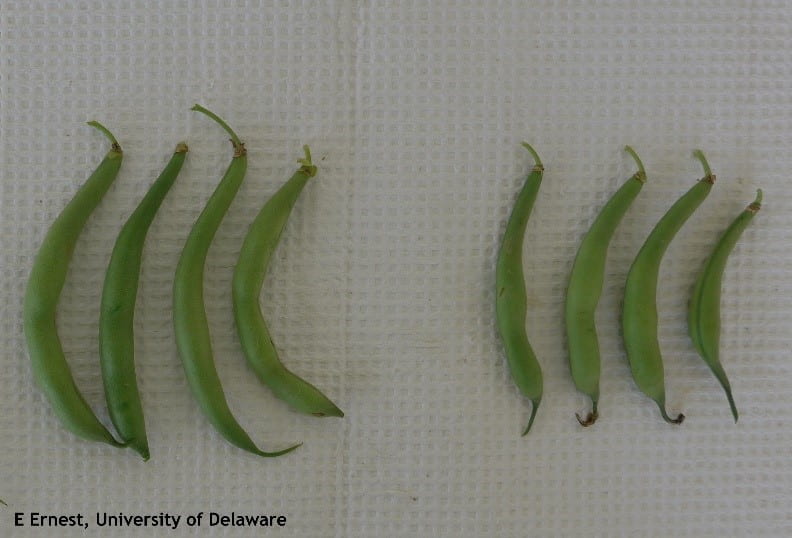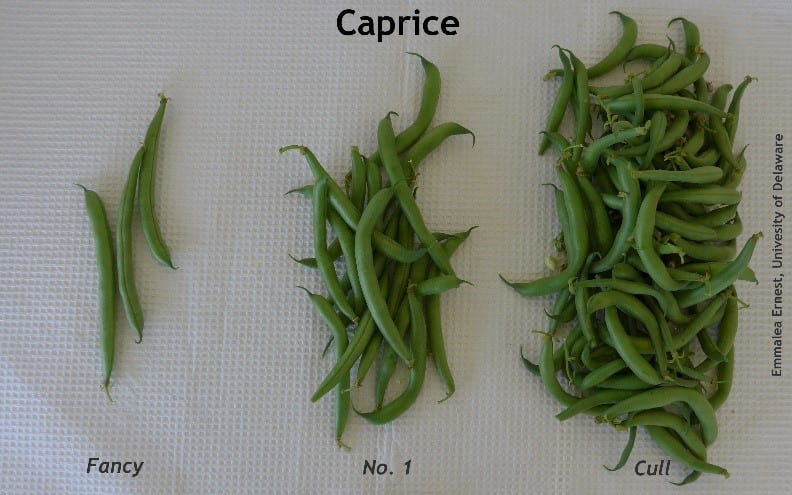Gordon Johnson, Extension Vegetable & Fruit Specialist; gcjohn@udel.edu and Emmalea Ernest, Associate Scientist – Vegetable Crops; emmalea@udel.edu
Vegetable harvest is peaking on Delmarva. Unfortunately, we often see pollination problems in fruiting vegetables when weather conditions are unfavorable and 2020 is no exception.
Signs of incomplete pollination in cucurbits include bottlenecked fruit or fruit with a pinched end, crooked or lopsided fruit, fruit small in size or nub-like; and fruits with prominent lobes or that are triangular in shape. Causes of incomplete pollination may be inadequate pollen transfer by pollinating insects; inadequate pollen sources (pollenizers); or hot, dry weather that reduces pollen viability or that desiccates flower parts during pollination. Research has shown that a minimum of 1,000 grains of pollen are required to be distributed over the three lobes of the stigma of the female flower of a watermelon to produce a uniformly shaped fruit.
Hollow cavities in fruit and vacant seed cavities are related to lack of seed formation, again traced back to poor pollination. Fruit tissue separation, such as hollow heart in watermelon, has also been linked to inadequate pollination and may be worsened by rapid fluctuation in environmental conditions affecting fruit development.
Each year we see pumpkin fields with poor fruit set or fruit carry. Remember that in larger pumpkin sizes, each plant will only carry 1-2 fruits. The large vining plants also need considerable space – 25 to 50 square feet per plant. While planting Jack-o-lantern types at higher densities might at first seem to be a way to achieve higher yields, interplant competition will increase and you can decrease fruit carry because of this competition.
Too much available nitrogen can also delay pumpkin fruit set so that many of the pumpkins that are produced do not reach maturity in time. Pumpkins do not normally need more than 80 lbs/acre N to grow a crop. Anything above 100 lbs/acre N will cause the pumpkins to put on excessive vine growth and limit fruiting.
A major reason for poor fruit set in some years is high temperatures during flowering in July. Day temperatures in the 90s or night temperatures in the high 70s will cause flower and small fruit abortion. For pumpkin growers that do wholesale and start shipping right after Labor Day, this will limit early pumpkin availability. Varieties vary considerably in their ability to tolerate heat and to set under hot conditions. Inadequate irrigation and excessive water stress can also reduce fruit set, increase abortions, and reduce fruit carry. High temperatures and water stress reduce photosynthesis and the ability of the plant to carry fruits. Drought can also cause a higher than normal male/female flower ratio, thus affecting the number of fruits per plant.
Sweet corn growers often see quality problems related to poor pollination as a result of high temperatures. This problem is more severe in less stress tolerant varieties and where irrigation is inadequate.
In corn silk elongation begins 7 to 10 days prior to silk emergence from the husk. Every potential kernel (ovule) on an ear develops its own silk that must be pollinated in order for the ovary to be fertilized and develop into a kernel. The silks from near the base of the ear emerge first and those from the tip appear last. Under good conditions, all silks for an ear will emerge and be ready for pollination within a span of 3 to 5 days and this usually provides adequate time for all silks to be pollinated before pollen shed ceases.
Pollen grains are borne in anthers, each of which contains a large number of pollen grains. The anthers open and the pollen grains pour out after dew has dried off the tassels. Pollen is light and can be carried considerable distances (up to 600 feet) by the wind. However, most of it settles within 20 to 50 feet. Pollen shed is not a continuous process. It stops when the tassel is too wet or too dry and begins again when temperature conditions are favorable.
Under favorable conditions, a pollen grain upon landing on a receptive silk will develop a pollen tube containing the male genetic material, develop and grow inside the silk, and fertilize the female ovary within 24 hours. The amount of pollen is rarely a cause of poor kernel set. Each tassel contains from 2 to 5 million pollen grains, which translates to 2,000 to 5,000 pollen grains produced for each silk of the ear shoot.
Poor seed set is often associated with poor timing of pollen shed with silk emergence (silks emerging after pollen shed). Shortages of pollen are usually only a problem under conditions of extreme heat and drought. Extreme heat and desiccating winds can affect pollen germination on silks or pollen tube development leading to poor seed set. Insects that clip silks during pollination can cause similar problems.
In tomatoes, day temperatures over 95°F and/or night temperatures in excess of 80°F can cause pollination problems due to reduced pollen production, reduced pollen viability, or reduced pollen germination or pollen tube production. This can lead to flower drop, smaller fruit, misshapen fruit, or reduced gel formation inside the fruit producing hollow areas. Temperatures of 75°F or above along with high humidity can lead to tomato pollen clumping and incomplete pollination. To manage these pollination related problems in tomatoes use “hot-set” type tomatoes bred for better production under heat conditions.
In snap beans and lima beans, plantings that flower and set pods during summer conditions when day and night temperatures are high will be susceptible to reduced sets and yields, split sets, small pods, and misshapen pods. Most of our currently grown lima bean varieties and many commercial snap bean varieties are susceptible to heat stress related yield losses due to reduced pollen production when nighttime temperatures are high before and during flowering. This is why bean crops are planted in certain periods to avoid pollination related losses (snap beans planted for spring and fall crops but avoiding summer crops, lima beans planted in June and early July for fall harvest).
Short and misshapen snap bean pods resulting from heat stress during flowering and pod set.
Grade distribution of 300 g of Caprice and PV 857 pods from a heat stressed trial. Heat susceptible Caprice has majority of pods graded cull; heat tolerant PV 857 has majority of pods in Fancy and No. 1 grades.



